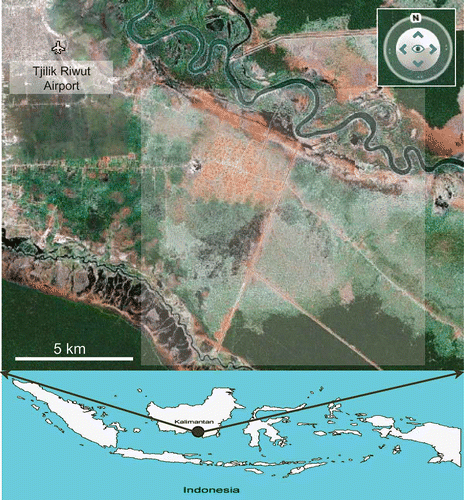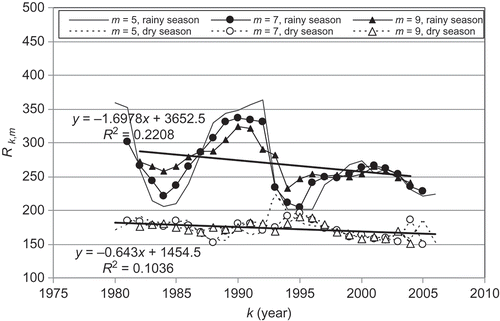Abstract
The effect of the El Niño Southern Oscillation (ENSO) on rainfall characteristics in the tropical peatland areas of Central Kalimantan, Indonesia, is demonstrated. This research used rainfall data collected between 1978 and 2008. The results suggest a relationship between ENSO events and the trend in rainfall observed in the study area. Further analyses show that El Niño events have a stronger effect on the rainfall compared to La Niña events. El Niño events were also correlated to the increase in the number of days with less than 1 mm of rainfall in the dry season. The analysis reveals that the impact of El Niño events on rainfall in dry seasons is intensifying annually. Furthermore, ENSO events are not the only factors affecting rainfall trends in the observed area. Other factors, such as deforestation, may also affect the trend.
Editor Z.W. Kundzewicz
Citation Susilo, G.E., Yamamoto, K., Imai, T., Ishii, Y., Fukami, H., and Sekine, M., 2013. The effect of ENSO on rainfall characteristics in the tropical peatland areas of Central Kalimantan, Indonesia. Hydrological Sciences Journal, 58 (3), 539–548.
Résumé
L'effet de l'oscillation australe El Niño (ENSO) sur les caractéristiques des précipitations dans les zones de tourbières tropicales du Kalimantan central, en Indonésie, est mis en évidence. Nous avons utilisé pour cette recherche des données pluviométriques recueillies entre 1978 et 2008. Les résultats suggèrent une relation entre les événements El Niño et la tendance des précipitations observées dans la zone d'étude. D'autres analyses montrent que le phénomène El Niño a un effet plus fort sur les précipitations qu'un évènement La Niña. Les événements El Niño ont également été corrélés avec l'augmentation du nombre de jours de moins de 1 mm de pluie pendant la saison sèche. L'analyse révèle que l'impact du phénomène El Niño sur les précipitations en saison sèche s'intensifie chaque année. En outre, les événements El Niño ne sont pas les seuls facteurs qui affectent les tendances pluviométriques dans la zone observée. D'autres facteurs, tels la déforestation, peuvent également influencer la tendance.
INTRODUCTION
The archipelago country of Indonesia historically comprised vast areas of wetlands, including 13.30 million ha of lowland swamp (39.8% of total wetland area) and 20.10 million ha of tidal marsh (60.2%). These wetlands were spread across the country's four major islands of Sumatra (9.37 million ha), Kalimantan (11.7 million ha), Sulawesi (1.79 million ha) and Papua (10.50 million ha). Of the original 33.40 million ha of wetlands throughout the country, approximately 3.90 million ha have been developed for agriculture and plantations (Harsono Citation2008).
Peatland areas, which are important carbon reservoirs, account for 22.5 million ha of wetlands in Indonesia. Peatland soils absorb and store more carbon than most other soils and, conversely, massive quantities of carbon are released as peatland areas are burned or converted to other land-cover types. These areas are rapidly decreasing due to anthropogenic activities, which have major implications for global climate change.
Between 1985 and 2005, the area of peatland forest on Kalimantan Island, Indonesia, decreased at a rate of 1.3% per year (CKPP Consortium Citation2008). In 1995, the Indonesian Government launched a project called the Mega Rice Project (MRP) in Central Kalimantan to support the national food programme. This project was a multibillion US dollar project that called for the conversion of natural peatland areas into paddy fields in both modern and integrated agricultural areas. Based on the recommendations of several international foundations and other government agencies, the programme was discontinued in 1999, because the conversion of these areas into paddy fields required the drainage of peatland ecosystems, resulting in the rapid decomposition of peat organic carbon and an increase in annual peat fires. The decomposition of organic carbon into carbon dioxide had, and will continue to have, major negative impacts on air pollution levels in Southeast Asia and on processes related to global climate change. A huge quantity of organic carbon has been converted into carbon dioxide and has polluted the atmosphere. Carbon emissions from the degraded peatland areas will continue until all the peat has disappeared. In addition, the land-cover change that occurred under this project ultimately resulted in flooding that destroyed newly created paddy fields, and seawater intrusion that contaminated local freshwater resources (Noor and Sarwani Citation2003).
Following the collapse of the Mega Rice Project, a major peatland restoration project was initiated in Central Kalimantan. In this programme, a strong understanding of wetland hydrology, including the connections between rainfall, runoff, groundwater and weather conditions, is critical. These hydrological conditions directly affect various processes governing hydro-period conditions in the wetland area and can themselves be influenced by environmental change related to weather patterns, weather anomalies, deforestation and land-use change. In particular, knowledge of the effect of environmental changes on hydrological characteristics is very important for gaining the understanding required for the effective and efficient restoration of peatland areas.
A major driver of environmental change in this region is the El Niño Southern Oscillation (ENSO). The ENSO can be described as a phenomenon consisting of two oceanic phases—the El Niño warm phase and the La Niña cold phase—that are connected through a fluctuation in atmospheric pressure over the South Pacific, called the Southern Oscillation (Shrestha and Kostaschuk Citation2005). During an ENSO event, which occurs on average every 3–7 years (Garcia et al. Citation2003), the surface temperature of the Pacific Ocean on the west coast of Ecuador and Peru is abnormally high with major world-wide consequences. The result is often flooding in regions such as coastal Peru and Ecuador, as well as drought conditions in regions like Indonesia, New Guinea and Australia (Cane Citation2005). Some research related to the effect of the ENSO in Indonesia (Nicholls Citation1981, 1984, Ropelewski and Halpert Citation1987, Konnen et al. Citation1998, Haylock and McBride Citation2001) has concluded that the inter-annual variability of monthly rainfall in Indonesia is strongly related to the ENSO (Hamada et al. Citation2002). Most of the areas observed for the research were Indonesian islands, especially in Java dan Sumatera Island.
The objective of the present study was to investigate how weather anomalies such as El Niño/La Niña influence precipitation characteristics in the Mega Rice Project area of Central Kalimantan. This study analyses more recent and longer time series of hydro-meteorological data obtained locally in Central Kalimantan and observed further inland. We analysed monthly precipitation data over peatland areas in Central Kalimantan with ENSO events from 1978 to 2008. The results of this research will be a significant contribution and an important input for the peatland restoration programme in Central Kalimantan in the future.
METHODS
Data
Hydrological data used in this study were recorded at a climatic station located at Tjilik Riwut Airport, Palangkaraya (the capital of Central Kalimantan Province; 2°16′0′′S–113°55′59′′E; ). The data set consists of daily and monthly rainfall data. Daily data are available for 27 years (1978–2004) and monthly data for 31 years (1978–2008). The data set was considered to be high quality with less than 1% missing data. According to this data set, the average annual rainfall in this area was 2865.8 mm with maximum and minimum annual rainfall of 3614.0 and 1899.0 mm, respectively (). Based on the values of the skewness coefficient (Cs) and kurtosis coefficient (Ck) of the data, the statistical distribution of the annual maximum daily rainfall at this station fell within a log-Pearson Type III distribution. On a daily scale, rainfall amounts ranged from 0 to 201 mm.
ENSO–rainfall relationship
Various methods can be used to determine the years of ENSO events. In this study, the Southern Oscillation Index method (SOI) was used to identify the strength and phase of ENSO events in the study area. The SOI is an index of the southern oscillation, a phenomenon that affects large-scale atmospheric and oceanographic features of the tropical Pacific Ocean (Adiku and Stone Citation1995). The oscillation can be characterized by an index based on variations in either sea-surface temperatures or differences in barometric pressures (MSLP) during the ENSO events. The SOI is negative during the warm El Niño phase and positive during the cold La Niña phase (Mabaso et al. Citation2009). In this study, the SOI was calculated as follows (Australian Bureau of Meteorology Citation2002):
The change in rainfall trends due to the El Niño and La Niña has been discussed by many researchers world-wide. For example, Kane (Citation1999) investigated characteristics and precipitation effects of the El Niño of 1997–1998. However, some of the previous research suggests that the ENSO is the most significant factor causing global hydroclimatic variability, especially in equatorial Pacific areas (Kahya and Dracup Citation1993, Allan Citation2000, Terry et al. Citation2001), and a major controlling factor of inter-annual climatic variability in tropical regions like Indonesia (Aldrian and Susanto Citation2003, McBride et al. Citation2003, Annas et al. Citation2007). In Indonesia, ENSO events predominantly cause a reduction in rainfall that results in a longer dry season with greater water evaporation and a shorter rainy season with greater surface runoff. The ultimate result is reduced ground and surface water storage.
The correlation between SOI and monthly rainfall amounts at the Palangkaraya hydrological station is investigated to determine the effect of ENSO on the hydrological condition in Central Kalimantan using the values of the correlation coefficients between monthly rainfall and monthly SOI for a specific month. The correlation coefficients are obtained by Pearson's correlation method, which is one of the most popular methods for measuring dependence between two quantities (Rodgers and Nicewander Citation1988):
Finally, the dynamic slope of the segmented regression between the annual average monthly rainfall and SOI is used to determine the strength of the ENSO impact on the rainfall. The segmented regression involves data of the observed year as the centre of the series and the data of the years around the observed year. The segmented regression is described in Equationequation (3)(3), from which the impact of ENSO toward rainfall trend—described as the dynamic slope—can be calculated. Furthermore, the regression of the dynamic slope can be determined. In order to investigate the possibility of factors other than ENSO affecting the annual rainfall trends, a new data series is created. The new series comprises “intercepts” that are derived also from the segmented regression for the annual average monthly rainfall and monthly SOI, as described in Equationequation (4)
.
RESULTS
Thirty-one years of rainfall data at Palangkaraya station indicated a dynamic linear decrease. The average annual rainfall decreased from 3100 mm to 2600 mm over three decades (1978–2008). The graph in presents rainfall trend of the dry season (May–October) and rainy season (November–April) for all years. Average rainfall decreased by 6.8 mm/year in the dry season and 4.8 mm/year during the rainy season ().
Fig. 3 Trend in annual rainfall during dry and rainy seasons at Palangkaraya station. The y-axis represents the annual sum of rainfall in a given season.
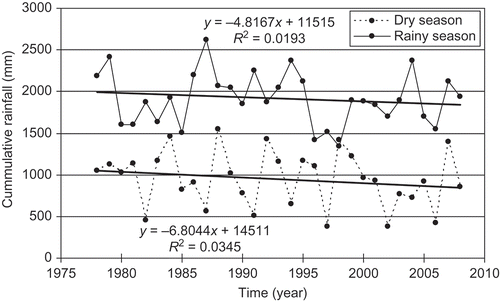
Correlation coefficients between monthly rainfall and SOI were obtained by analysis of the effect of the ENSO on the hydrological conditions in Central Kalimantan. De-trending of the data, by subtracting the best-fit line (in the least-squares sense) from the data, was performed before conducting the correlation analysis, and the values of correlation coefficients are presented in Fig. 4. indicates a positive relationship between ENSO events and rainfall in the month of March and between May and November, as well as a negative relationship from December to February and in the month of April. Correlation coefficients for the dry season had an average of 0.47. The months between July and October are typically sensitive to the effects of ENSO; however, these months had only moderate correlation coefficients (0.3 < r < 0.7). The r values for July–October are: 0.53 (p = 0.002), 0.68 (p < 0.001), 0.50 (p = 0.007) and 0.64 (p < 0.001), respectively. Other months showed weak correlation to the effects of ENSO, indicated by small correlation coefficients (–0.3 < r < 0.3) and p values of between 0.080 and 0.822.
Fig. 4 Correlation coefficients between annual average SOI and monthly rainfall at Palangkaraya station for the 1978–2008 period.
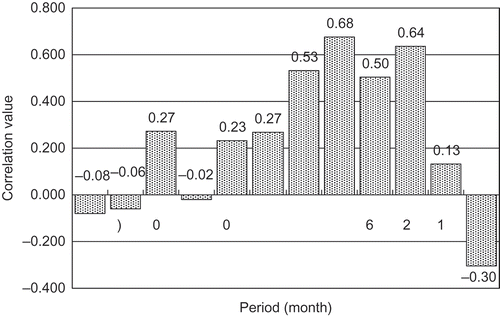
Based on the consensus of several institutions, such as the Western Regional Climate Center, USA, the Climate Diagnostics Center of the NOAA and the Climate Prediction Center of the US National Weather Service, El Niño events occurred in 1982, 1987, 1991, 1992, 1994, 1997, 2002 and 2006, with the most extreme El Niño event occurring in 1997. La Niña events occurred in the years 1988, 1998, 2000 and 2007, with strongest La Niña event occurring in1988 (Null Citation2007). shows the comparison between the average rainfall of El Niño years, La Niña years and ordinary years (years with no El Niño or La Niña) for dry and rainy seasons. It can be seen from that, during El Niño years, the average rainfall in dry seasons was quite low (75.3 mm) compared to that of ordinary years (170.0 mm). In contrast, during La Niña years, the average rainfall in dry seasons was (221.6 mm), which was higher than that of ordinary years. Both El Niño and La Niña seem to essentially influence the dry season. Surprisingly, effects of El Niño and La Niña were not clearly shown in the average rainfall in rainy seasons. The average rainfall in rainy seasons for El Niño years, La Niña years and ordinary years was similar, at 319.7, 309.1 and 321.1 mm, respectively.
Fig. 5 Comparison between average dry season and rainy season rainfall in El Niño, La Niña and ordinary (i.e. non El Niño and La Niña) years.
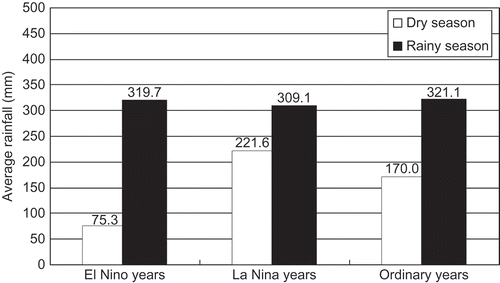
The ENSO events affect the pattern of the number of “rainy days” and “no rain days” or days with precipitation less than 1 mm. shows the number of “no rain days” from the annual data for 1978–2008. The graph in shows that the number of “no rain days” is generally high during El Niño events and low during La Niña events. In all years of El Niño events, the number of “no rain days” is more than the average number of “no rain days” for all years. However, in all years of La Niña events, the number of “no rain days” is less than the average number of “no rain days” for all years. The strongest El Niño happened in 1997, when the number of “no rain days” increased dramatically to 176 days. The year 1988 is recorded as a strong La Niña year. However, the number of “no rain days” for this year is not significantly different from the number of “no rain days” in other La Niña years.
Fig. 6 Number of “no rain days” (i.e. with <1 mm rainfall) between 1978 and 2008. White bars denote the days during El Niño events, black bars—days during La Niña events, and shaded bars—days during ordinary years.
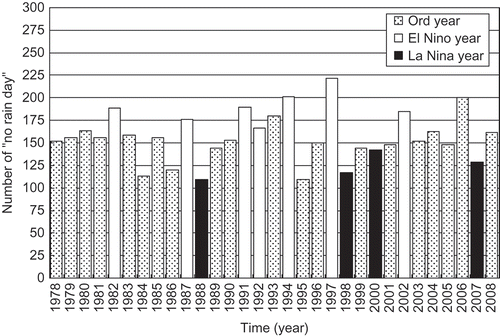
Dynamic slopes formed by segmented regression for m = 5, m = 7 and m = 9 showed positive trends, demonstrating that the impact of ENSO on the rainfall of the area observed increased periodically. The results of the analysis are displayed for different decades in . illustrates the trend examples of dynamic slopes for the rainy season and dry season for m = 7. The values in indicate that the absolute value of the dynamic slopes for the dry season are larger than those of the rainy season for all values of m, suggesting that ENSO effects on rainfall during the dry season were stronger than during the rainy season.
Table 1 Dynamic slopes and their regression coefficients for the a k,m series formed by the segmented regression for m = 5, m = 7 and m = 9 for the years, k = 1983, 1993 and 2003
Fig. 7 Dynamic slopes formed by the segmented regression for m = 7 (ak ,7) using data spanning the years 1978–2008. The upper line is the trend of ak,m for the dry season; the lower one is that for the rainy season.

The new data series calculated from the intercepts of the segmented regression analysis of annual average monthly rainfall and monthly SOI was generated to investigate the possibility that factors other than ENSO might affect the annual rainfall. The data were obtained from segmented regression analysis as described in Equationequation (4). In this series, it is assumed that the trend of the data is not affected by the ENSO. However, from the graphs in , a negative trend can be seen for both the dry and rainy seasons, suggesting that there may be other factors in addition to ENSO that affect rainfall trends in the study area.
DISCUSSION
El Niño Southern Oscillation events are known to influence rainfall in Indonesia, resulting in prolonged droughts and declines in rainfall throughout the country during the dry season. Although the correlation values during these months were less than 0.7 (indicating a non-significant correlation), the results support there being a relationship between ENSO events and a decrease in rainfall in Central Kalimantan peatland areas, particularly during dry season months (May–October). This trend is consistent with previous results showing that El Niño events, characterized by negative SOI values, typically occur between June and October in Indonesia (Hamada et al. Citation2002).
The results also show that El Niño events corresponded to low average monthly rainfall, suggesting that drought conditions in this area are related to ENSO events. Previous studies have shown that El Niño is associated with drought events in many parts of the world (Ropelewski and Halpert Citation1987, Kane Citation1999). However, La Niña tended to increase the potency of rainfall in the areas of the western equatorial Pacific, such as Indonesia, Malaysia and northern Australia. Furthermore, the results confirmed that climatic responses in this region to ENSO events were stronger during the dry season. Both El Niño and La Niña seem to influence the rainfall in the dry season. El Niño reduced the amount of rainfall in the dry season and, conversely, La Niña increased it.
The ENSO events reduce the number of days with measurable rainfall amounts, while increasing the number that had less than 1 mm of rainfall in every data year. This can be explained by the fact that El Niño events decrease sea-surface temperature due to the movement of warm water vapour in the Pacific Ocean. As a consequence, cloud production in the atmosphere above Indonesia is reduced, further decreasing rainfall production. The effects of El Niño events in Indonesia can also be exacerbated by forest fires that are more likely to occur during the dry season, releasing smog emissions into the atmosphere. This smog can be extensively distributed throughout the atmosphere and persist for long periods, and may also reduce cloud generation and decrease rainfall quantities (As-syakur Citation2010).
The impacts of ENSO on rainfall appear to be increasing annually as shown by the positive trend in ak,m for both dry and rainy seasons. This suggests that El Niño events drive the decline in rainfall during both seasons. The positive trend in the data indicates the dynamic increase of El Niño effects on the rainfall decrease. However, El Niño-related impacts on rainfall are not as substantial in the rainy season as compared to the dry season. The results support the conclusions of the Climatology, Meteorology, and Geophysics Agency of Indonesia regarding the potential increase in the intensity of the effects of ENSO events on climate, especially rainfall, in Indonesia (Ikawati Citation2010).
It was also determined that ENSO events are not the only factors affecting rainfall trends in Central Kalimantan during the rainy season. Although the results in this paper do not address this aspect of the question, deforestation in this region could be another factor affecting rainfall trends in Central Kalimantan. Deforestation and corresponding decreases in rainfall in tropical forests has been investigated by many researchers (Wright and Calderon Citation2006, Rollenbeck and Anhuf Citation2007, Vincent et al. Citation2009). Deforestation changes surface energy budgets, decreases latent heat fluxes from the surface to the atmospheric boundary layer and increases sensible heat fluxes (Lawton et al. Citation2001, Nair et al. Citation2003, Ray et al. Citation2006a). The result is hotter and drier air over deforested areas, which could reduce dry-season cloud formation and precipitation (Ray et al. Citation2006b). In other words, the decrease in forest cover reduces the canopy areas that stabilize surface energy budgets and keep hydrological cycles steady. However, it is quite complicated relationship and it is difficult to quantify climate effects and deforestation effects in Central Kalimantan peatland areas. The above analysis indicates that both ENSO, as an external factor, and potentially deforestation, as an internal factor, have important influences on the amount of rainfall received in this area.
CONCLUSION AND RECOMMENDATION
The effects of ENSO events on rainfall in tropical peatland areas of Central Kalimantan have been discussed in this paper. The research indicates that ENSO events affect the amount of rainfall in this region, especially during the dry season. The research also demonstrates that El Niño events had a stronger impact on hydrological performance than La Niña events in the peatland areas over the observed period. Specifically, El Niño events increased the number of days with less than 1 mm of rainfall in the dry season. In addition to ENSO events, another unrelated factor may have decreased rainfall in the study area: deforestation that has been occurring for over 30 years in Central Kalimantan and has gradually decreased the forest cover. Previous research has shown a link between the reduction in the amount of rainfall and the destruction of tropical forests. However, a quantitative analysis of the effect of deforestation on rainfall decrease was not undertaken; to evaluate the effects of deforestation on the decreasing trend of rainfall quantitatively, more data and analysis are needed.
Acknowledgements
The authors thank Dr Hidenori Takahashi of the Hokkaido Institute of Hydro-Climate for supplying excellent hydrological data for this research and JST/JICA for financing the project. The first author wishes to acknowledge support from the Directorate General of Higher Education of Republic of Indonesia who financed him to carry out this research in Yamaguchi University, Japan.
REFERENCES
- Adiku , S.G.K. and Stone , R.C. 1995 . Using the Southern Oscillation Index for improving rainfall prediction and agricultural water management in Ghana . Agricultural Water Management , 29 ( 1 ) : 85 – 100 .
- Aldrian , E. and Susanto , R.D. 2003 . Identification of three domain rainfall regions within Indonesia and their relationship to sea surface . Climatology , 23 : 1435 – 1452 .
- Allan , R.J. 2000 . “ ENSO and climatic variability in the past 150 years. In ” . In Multiscale variability and global and regional impacts , Edited by: Diaz , H.F. and Markgraf , V. 3 – 55 . Cambridge : Cambridge University Press .
- Annas , S. , Kanai , T. and Koyama , S. 2007 . Assessing daily tropical rainfall variations using a neuro-fuzzy classification model . Ecological Informatics , 2 : 159 – 166 .
- As-Syakur, A., 2010. The impact of El Niño and La Niña in Indonesia [online]. http://mbojo.wordpress.com/2010/03/18/el-nino-dan-la-nina-serta-dampaknya-di-indonesia/ (http://mbojo.wordpress.com/2010/03/18/el-nino-dan-la-nina-serta-dampaknya-di-indonesia/) (Accessed: 1 January 2010 ).
- Australian Bureau of Meteorology, 2002. Climate glossary [online]. Australian Bureau of Meteorology. http://www.bom.gov.au/climate/glossary/soi.shtml (http://www.bom.gov.au/climate/glossary/soi.shtml) (Accessed: 1 January 2010 ).
- Cane , M.A. 2005 . Frontiers: the evolution of El Niño, past and future . Earth and Planetary Science Letters , 230 : 227 – 240 .
- CKPP (Central Kalimantan Peatlands Project) Consortium, 2008. Q and A regarding peat in Southeast Asia, especially in Indonesia [online]. Wetland International. http://wetlands.40fingers.eu/LinkClick.aspx?fileticket=1Mu2MNJxbcU%3Dandtabid=56 (http://wetlands.40fingers.eu/LinkClick.aspx?fileticket=1Mu2MNJxbcU%3Dandtabid=56) (Accessed: 1 January 2010 ).
- Garcia , A.M. , Vieira , J.P. and Winemiller , K.O. 2003 . Effects of 1997–1998 El Niño on the dynamics of the shallow-water fish assemblage of the Patos Lagoon Estuary (Brazil) . Estuarine, Coastal and Shelf Science , 57 : 489 – 500 .
- Hamada , J. 2002 . Spatial and temporal variations of the rainy season over indonesia and their link to ENSO . Journal of the Meteorological Society of Japan , 80 ( 2 ) : 285 – 310 .
- Harsono , E. 2008 . The role of flow system on hydrological network in supporting land productivity in the tidal marsh area . Indonesian Journal of Water Resources (JSDA) , 4 ( 20 ) : 125 – 138 .
- Haylock , M. and McBride , J.L. 2001 . Spatial coherence and predictability of Indonesian wet season rainfall . Journal of Climate , 14 : 3882 – 3887 .
- Ikawati, Y., 2010. El Niño is not always dry [online]. Jateng, Indonesia: BPDB. http://bpbdjateng.info/index.php?option=com_contentandview=articleandid=699el-nino-tak-lagi-selalu-keringandcatid=65:iptek-kebencanaan (http://bpbdjateng.info/index.php?option=com_contentandview=articleandid=699el-nino-tak-lagi-selalu-keringandcatid=65:iptek-kebencanaan) (Accessed: 1 January 2010 ).
- Kahya , E. and Dracup , J.A. 1993 . US streamflow patterns in relation to the El Niño Southern Oscillation . Water Resources Research , 29 ( 8 ) : 2491 – 2503 .
- Kane , R.P. 1999 . Some characteristics and precipitation effects of the El Niño of 1997–1998. Review paper . Journal of Atmospheric and Solar-Terrestrial Physics , 61 : 1325 – 1346 .
- Konnen , G.P. 1998 . Pre-1866 extensions of the southern oscillation index using early Indonesian and Tahitian meteorological readings . Journal of Climate , 11 : 2325 – 2339 .
- Lawton , R.O. 2001 . Climatic impact of tropical lowland deforestation on nearby montane cloud forests . Science , 294 : 584 – 587 .
- Mabaso , M.L.H. 2009 . El Niño Southern Oscillation (ENSO) and annual malaria incidence in Southern Africa . Royal Society of Tropical Medicine and Hygiene , 101 : 326 – 330 .
- McBride , J.L. , Haylock , M.R. and Nicholls , N. 2003 . Relationships between the maritime continent heat source and the El Niño southern oscillation phenomenon . American Meteorological Society , 16 : 2905 – 2914 .
- Nair , U.S. 2003 . Impact of land use on Costa Rican tropical mountain cloud forests: sensitivity of cumulus cloud field characteristics to lowland deforestation . Journal of Geophysical Research , 108 ( D7 ) : 4206 doi: 10.1029/2001JD001135
- Nicholls , N. 1981 . Air–sea interaction and the possibility of long-range weather prediction in the Indonesian archipelago . Monthly Weather Review , 109 : 2435 – 2443 .
- Nicholls , N. 1984 . The Southern Oscillation, sea-surface temperature, and interannual fluctuations in Australian tropical cyclone activity . Journal of Climatology , 4 : 661 – 670 .
- Noor , M. and Sarwani , M. 2003 . “ Agriculture in peatlands: in the past, today, and tommorow ” . In Proceeding of workshop on wise use and sustainable peatlands management practices 291 – 295 . 13–14 October 2003, Bogor
- Null, J., 2007. El Niño and La Niña years: A consensus list [online]. Golden Gate Weather Service. http://ggweather.com/enso/years.htm (http://ggweather.com/enso/years.htm) (Accessed: 1 January 2010 ).
- Ray , D.K. 2006a . Impact of land use on Costa Rican tropical montane cloud forests: sensitivity of orographic cloud formation to deforestation in the plains . Journal of Geophysical Research , 111 : D02108 doi: 10.1029/2005JD006096
- Ray , D.K. 2006b . Dry season clouds and rainfall in northern Central America: implications for the Mesoamerican Biological Corridor . Global and Planetary Change , 54 : 150 – 162 .
- Rodgers , J.L. and Nicewander , W.A. 1988 . Thirteen ways to look at the correlation coefficient . The American Statistician , 42 : 59 – 66 .
- Rollenbeck , R. and Anhuf , D. 2007 . Characteristics of the water and energy balance in an Amazonian lowland rainforest in Venezuela and the impact of the ENSO-cycle . Journal of Hydrology , 337 : 377 – 390 .
- Ropelewski , C.F. and Halpert , M.S. 1987 . Global and regional scale precipitation patterns associated with the El Niño/southern oscillation . Monthly Weather Review , 115 : 1606 – 1626 .
- Ropelewski , C.F. and Halpert , M.S. 1989 . Precipitation patterns associated with the high index phase of the Southern Oscillation . Journal of Climate , 2 : 268 – 289 .
- Shrestha , A. and Kostaschuk , R.A . 2005 . El Niño/Southern Oscillation (ENSO)-related variability in mean-monthly streamflow in Nepal . Journal of Hydrology , 308 : 33 – 49 .
- Terry , J. , Raj , R. and Kostaschuk , R.A. 2001 . Links between the Southern Oscillation index and hydrological hazards on a Tropical Pacific Island . Pacific Science , 55 ( 3 ) : 275 – 283 .
- Vincent , G. , de Foresta , H. and Mulia , R. 2009 . Co-occurring tree species show contrasting sensitivity to ENSO-related droughts in planted dipterocarp forests . Forest Ecology and Management , 258 : 1316 – 1322 .
- Wright , S.J. and Calderon , O. 2006 . Seasonal El Niño and longer term changes in flower and seed production in a moist tropical forest . Ecology Letters , 9 : 35 – 44 .
